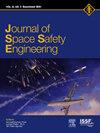降低长期再入偏心倾斜地球同步(苔原)处置轨道的航天器再入大气层的伤亡风险
IF 1.7
Q3 ENGINEERING, AEROSPACE
引用次数: 0
摘要
本文考虑了偏心倾斜地球同步轨道(偏心 IGSO)上航天器和末级的处置问题,特别是被称为苔原轨道的类别。美国政府于 2019 年 12 月发布的《轨道碎片缓减标准实践》(ODMSP)包括一个处置选项,即利用轨道偏心率增长在 200 年内进行长期重返,该选项可用于苔原轨道。该处置方案的一个条件是限制再入大气层的伤亡风险。对一般的冻原航天器和冻原弃星轨道上的典型末级进行了分析,以评估再入大气层的伤亡风险。从考虑到冻原弃星轨道偏心率增长的传播扫描中,选择了几种冻原弃星轨道情况进行再入大气层分析。对这些情况进行了再入大气层风险分析,假定从近似圆形轨道再入大气层。结果表明,一般冻原航天器和典型末级的预测伤亡风险远远超过了 ODMSP 中允许的风险限度。然后对从选定的 "苔原 "弃星轨道再入大气层的情况进行了分析,考虑到了再入大气层前偏心率增长造成的高偏心率。结果表明,地球上重返点的分布可能集中在南半球的海洋上,因为那里的人口较少。结果发现,一般的 "苔原 "航天器和所考虑的一个末级符合 ODMSP 中万分之一的预期伤亡限制。这些结果表明,有希望在ODMSP中更广泛地使用长期重返选项。本文章由计算机程序翻译,如有差异,请以英文原文为准。
Reducing reentry casualty risk for spacecraft on long-term reentering eccentric inclined geosynchronous (Tundra) disposal orbits
This paper considers disposal of spacecraft and upper stages on eccentric inclined geosynchronous orbits (eccentric IGSOs), specifically the class known as Tundra orbits. The U.S. Government Orbital Debris Mitigation Standard Practices (ODMSP) released in December 2019 include a disposal option to use orbital eccentricity growth for long-term reentry within 200 years that could be used for Tundra orbits. A condition of this disposal option is that reentry casualty risk be limited. An analysis was performed to assess reentry casualty risk for a generic Tundra spacecraft and typical upper stages on Tundra disposal orbits. From propagation sweeps accounting for eccentricity growth of Tundra disposal orbits, several Tundra disposal orbit cases were selected for reentry analysis. A reentry risk analysis for these cases assuming reentry from near-circular orbits was performed. Results show that predicted casualty risk for the generic Tundra spacecraft and typical upper stages well exceed allowable risk limits in the ODMSP. An analysis of reentry from the selected Tundra disposal orbits accounting for the high eccentricity due to eccentricity growth just before reentry was then performed. Results show that the distribution of reentry points on the Earth can be concentrated over ocean in the southern hemisphere where there is less human population. The generic Tundra spacecraft and one of the upper stages considered were then found to be compliant with the limit of 1 in 10,000 expected casualties in the ODMSP. These results indicate promise for wider usage of the long-term re-entry option in the ODMSP.
求助全文
通过发布文献求助,成功后即可免费获取论文全文。
去求助
来源期刊

Journal of Space Safety Engineering
Engineering-Safety, Risk, Reliability and Quality
CiteScore
2.50
自引率
0.00%
发文量
80
 求助内容:
求助内容: 应助结果提醒方式:
应助结果提醒方式:


